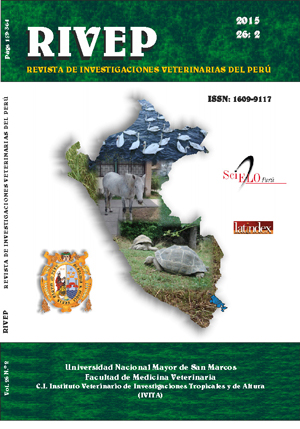Prevalence of Linguatula serrata nymphs in cattle in abattoirs in Lima, Peru
DOI:
https://doi.org/10.15381/rivep.v26i2.11091Keywords:
Linguatula serrata, mesenteric lymph nodes, prevalence, cattle, slaughterhouseAbstract
Linguatulosis is a zoonosis caused by Linguatula serrata. The nymph and adult stages of the parasite can affect humans, and the man main mechanisms of transmission is through contact with domestic dogs and ingestion of uncooked infected cattle viscera. This study aimed to determine the prevalence, mean abundance, and the mean intensity of the nymphal stage ofL. serrata in mesenteric lymph nodes of cattle slaughtered in two abattoirs in Lima, Peru. The animals were brought from the departments of Puno, Junín, La Libertad, Amazonas, Pasco and Lima. A total of 3576 lymph nodes from 368 cattle were collected, fat was removed and stored at 5 °C. Nodes with micro abscesses, calcified granulomas and yellow, green or gray nodules were selected and longitudinal cuts were done. Nymphs were fixed and mounted for evaluation. Results of the morphometry showed averages of 4.95 mm total length, 1.39 mm anterior width and 0.76 mm posterior width. The prevalence of infection by nymphs ofL. serrata was 5.97%, especially in 4-5 years old animals. The most frequent affected cattle were from Chachapoyas, Amazonas (13/121) and Huancayo, Junín (6/70). The mean abundance was 0.14 (0-2) and the mean intensity was 2.5 (2-3).Downloads
Downloads
Published
Issue
Section
License
Copyright (c) 2015 Julia Castro, Asucena Naupay, Narda Fajardo, Giannina Trevejo, Víctor Almeyda, Esperanza Fajardo, Karina Faustino

This work is licensed under a Creative Commons Attribution-NonCommercial-ShareAlike 4.0 International License.
AUTHORS RETAIN THEIR RIGHTS:
a. Authors retain their trade mark rights and patent, and also on any process or procedure described in the article.
b. Authors retain their right to share, copy, distribute, perform and publicly communicate their article (eg, to place their article in an institutional repository or publish it in a book), with an acknowledgment of its initial publication in the Revista de Investigaciones Veterinarias del Perú (RIVEP).
c. Authors retain theirs right to make a subsequent publication of their work, to use the article or any part thereof (eg a compilation of his papers, lecture notes, thesis, or a book), always indicating the source of publication (the originator of the work, journal, volume, number and date).










